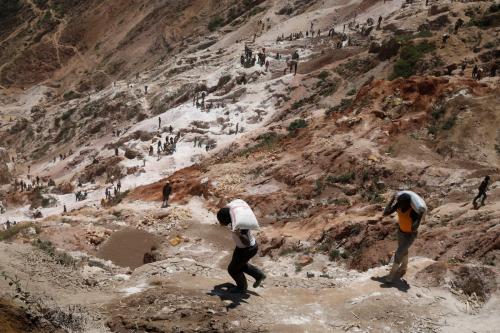President Obama’s decision to draw down 30 million barrels of crude oil from the Strategic Petroleum Reserve (SPR), in concert with a similar drawdown by other members of the International Energy Agency, is ill-advised. The decision is at sharp odds with the reason that the SPR was originally created. For many years, the major focus of emergency oil supply planning has been the development of a strategic oil reserve program. Strategic stockpiling has been a part of U.S. defense policy since 1912 when President Taft set aside petroleum fields to ensure strategic stocks for the navy. In the aftermath of the embargo of 1973-1974 by the Organization of Arab Petroleum Exporting Countries (OAPEC), Congress passed the energy Policy and Conservation Act in 1975 authorizing the creation of a Strategic Petroleum Reserve Project Management Office (SPRO), which established for the first time the concept of a petroleum reserve for the civilian economy.
The stockpiling of emergency reserves is designed, at least in part, to deter the international curtailment of oil supplies to the United States. Following the creation of the International Energy Agency’s oil-sharing mechanism, each member of the IEA agreed to hold “strategic stocks” to share with the other members in the event that any member state experienced a seven percent or greater shortfall in its oil supplies. While the operational details of the oil sharing mechanisms are complex, the SPR is America’s contribution to this effort. In the event of a major disruption, the United States is required to share the stockpiles in the SPR with IEA members as well as to meet our own needs. With the Middle East and North Africa now in a political imbroglio that could well become far worse, it seems unwise to use the SPR—particularly at a time when the ongoing global economic slowdown is driving down crude prices. Even in the absence of a major crisis, by drawing down the SPR today in response to high oil prices, we leave ourselves open to the risk of even higher oil price in future when we come to replenish supplies.
From its formation, the SPR has been subject to controversy over several issues including how fast it should be filled; its size—particularly in relation to the nation’s oil import dependency; the level of protection it provides; and the cost of that protection relative to other pressing social and economic priorities. The SPR fill rates have been determined more by domestic political considerations rather than firm assessments of global oil supply and demand. This has sometimes exacerbated tensions with our traditional allies in the oil producing world as the United States has restocked—and thereby raised demand—at the same time as pressuring Saudi Arabia to raising production. As currently structured, the SPR feeds into the U.S. pipeline network and is seen as the “hub” of America’s emergency spare wheel. Can it do the job? Some analysts believe that the SPR would not be adequate in the event of a major disruption. According to this view, if the United States lost imports faster than it could draw down the SPR, shortages would appear throughout the system. As an alternative, it has been suggested that the United States implement a regional SPR system; however, this would entail higher costs and, in some places, above-ground facilities in some areas that could be subject to sabotage.
One approach that merits detailed examination for the future is whether the SPR might be strengthened by establishing an industrial petroleum reserve (IPR) as called for in the original SPRO legislation. Some countries, such as Japan, Germany and the Netherlands, have joint public-private arrangements for strategic reserves, while in other countries national oil companies manage oil strategic stocks. There are many good arguments for diversifying our oil reserve system either through financial support for commercial stockpiles or by mandating certain reserve inventories to be held by the private sector. Clearly, the private sector might be able to manage the SPR more efficiently and at a lower cost. Likewise because private sector stocks would be dispersed around the country, unique crisis situations hitting some regions more than others could be better managed. Private firms could also be encouraged to hold petroleum products thereby reducing the lead time in drawing down the SPR, getting the crude refined and into the marketplace. The higher costs of storage could be passed onto the consumer; while this would probably be politically unpopular, higher prices might induce more conservation than the current arrangements in which the SPR is funded by the taxpayer in the federal budget. The chief disadvantage of an IPR would be the diversion of capital away from other productive enterprises and concern that in a competitive marketplace the industry might not be able to recover its costs since each firm would have a different marginal cost curve.
The decision to use strategic stocks is never easy—crises by their very nature are difficult to predict and manage, making the use of one-time emergency measures a calculated gamble at beset. However, using the SPR to deal with high oil prices in a time of economic sluggishness is misguided—especially when crude prices are falling and both the administration and Congress seem unable to take measures for sustainable economic or energy security.
The Brookings Institution is committed to quality, independence, and impact.
We are supported by a diverse array of funders. In line with our values and policies, each Brookings publication represents the sole views of its author(s).


Commentary
Drawing Down the Strategic Petroleum Reserve: Bad Policy, Bad Timing
June 27, 2011